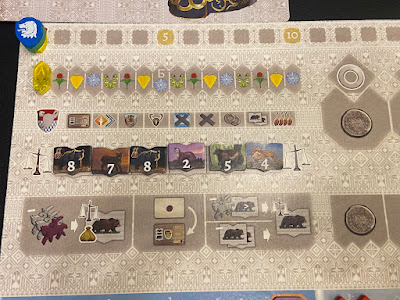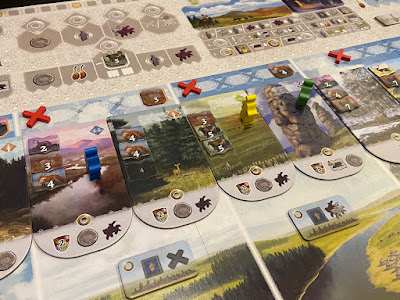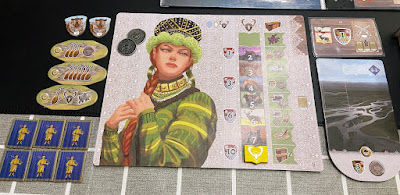The Game
Stroganov is a 2021 game by Andreas Steding. He is the designer of Hansa Teutonica, a game I greatly admire. He also designed Gugong and The Staufer Dynasty. Stroganov is set in 16th century Russia, when the Stroganov family was helping the Tsar explore and colonise Siberia. In the game you will travel east to explore, hunt animals, establish outposts and buy land. The game is played over 12 rounds. Highest scorer wins after 12 rounds.
This is the game board. The row in the middle consists of 12 land tiles and it represents Siberia. The land tiles are randomly set up every game, and during play tiles will shift.
The Siberian land tiles are populated with animals of different types. You get to hunt these animals for hide. Animals are numbered 1 to 8. They are different animals. Being numbered is just for ease of play so that you don't need to squint. Also the animals often need to be sorted in a particular order, so the numbers help with that. Player pawns start at the far left.
That track near the top with the transparent yellow marker is the progress track. Each space is one of the four seasons, and there are four years represented. Every season is one round of play. You only take actions in spring, summer and autumn. Winter is just for admin and reset. So you don't play 16 rounds. You play 12 rounds.
This is the reference chart telling you what you do on your turn (left half), and what you do during winter (right half). On your turn you must move eastwards. Then you may perform up to three actions. The first two are free, but if you want to perform the third action, you must pay a fee.
In winter, all pawns return to Moscow to rest. The board is reset. Some spaces where items have been taken from will be refilled. You also get to collect horses (a resource).
These are your basic actions (silver circle means basic action). You can take money, move, take horses, and hunt. The second row means you can pay a #5 hide to perform two of the actions listed. Hunting is one of the most important things you do in this game, because hide is your most important resource. Many things require paying hide. When you hunt and claim an animal tile, that space will not be refilled. Animals will gradually be depleted. The only way more animals become available is when you buy land. When you do so, you claim the land tile, leaving a void. During winter, land tiles are shifted left to close the gaps, and then new land tiles (with animals) will enter play on the right end.
This in the middle is the story track. When you complete amazing feats people sing praises of you. In winter, you can trade your story points for various benefits.
Siberia is divided into 5 regions, and each region has a village, a yurt and a Tsar's will card. Notice the golden circles next to them. The golden circle means they are associated with an advanced action. Villages and yurts are simple - you get to claim what's depicted on them. The difference between them is villages are permanent, whereas yurts are single-use. Once you use a yurt, it is discarded. New yurts are only placed during winter. The Tsar's will cards are missions you can complete. When you manage to do so, you score points and also gain some special ability.
This particular Tsar's will requires having two #6 hides, and then discarding one of them (that's what the red outline means). You'll score 1 point for this, and the ability gained is you can hunt not only in the land tile you are on, but also in adjacent land tiles.
All these are animals (or hides, after they are hunted). Those two on the bears (#8) are not chicken drumsticks. They are lutes. Lutes represent story points. If you manage to hunt a bear, people will tell stories of you.
This is a player board. The player boards differ. The track here is called the trophy track. Every time you advance on this track, you get to claim a benefit on the right. To advance, you have to take the trophy action and also pay the corresponding hide. At game end, you score points based on your progress. Final scores are around 40 to 50, so 10 points from completing your trophy track is significant.
You will keep moving east (right). You'll be hunting animals for hide and then using hide to do all sorts of things. Not many actions in the game score points. Every point feels precious. You don't score many points during the game. Most of the points are scored at game end. The three main sources of points are land tiles you buy, your progress on the trophy track, and outposts you build.
The Play
Nicholas, Vincent and I had a funny incident. As we played, we found the game horribly painful. Resource collection was slow. It took a long time to get anything meaningful done. We were almost at mid game before we decided to double check the rules. It was then we realised we had made a big mistake. We thought we could only take two actions per turn, one free and one paid. The correct rule was three actions - two free and one paid. No wonder our progress was so slow. We reset the game and restarted. The correct rules made a huge difference. So, the designer wasn't trying to illustrate how hard it was to colonise Siberia by making life difficult for us.
In general this is still a pretty Euro style game of collecting resources then converting them to points. One interesting challenge Stroganov presents is that many actions require a very specific hide type. You need to think of hides not as one resource type, but as eight different resource types. Hides are numbered 1 to 8. For example when I need to advance on my trophy track, the first step requires that I pay a #1 hide. I will need to specifically look for that animal to hunt in Siberia. My eastward movement has few opportunities for going in reverse, so I have to plan carefully where to stop and what to do. Sometimes others hunt the animals I need, completely screwing up my plan, and I will have to rethink. If your third action is a special action, you need to pay a specific hide type too. You may already need to plan for hunting the right animal type two rounds earlier. This game requires much meticulous planning.
The depletion of animals creates a feeling of impending doom. As you run out of animals to hunt, you need to move further and further east to find animals. Having someone buy land is important, because that's the only way new animals will enter the game. In our game Vincent was the only one focusing on buying land. Nicholas and I only bought a few pieces, half-heartedly. We both focused on on building outposts. Since neither of us competed with Vincent in buying land, he was able to pick up good deals and plan optimal moves without interference. Eventually he won with a huge margin. Since Vincent did not bother with outposts at all, Nicholas and I did not have problems building all our outposts. There was enough space for both of us. We scored the maximum points. Building outposts was not just for the points. Outposts provide a big convenience. Normally you can only perform special actions associated with the area you are physically in. However if you have built an outpost in a particular area, you will always have access to special actions there.
There is no land tile below the green pawn because it has been purchased. The crosses are the outposts. Since we did a 3-player game, a neutral colour (red) was used to block off one of the outpost slots.
Most of the Tsar's will cards are hard to fulfil. Their abilities are attractive, but many are really challenging. I think you need to be content with having fulfilled one or two in the early game. If it takes too long to fulfil, you won't be able to use it much before the game ends. It might not be worth the effort.
This was the late game. No more animals on the left side. Animals could only be found on the newer tiles on the right.
By game end I was able to complete advancing on my trophy track. However the others were able to do the same too, so I did not get any advantage out of this. I only made sure I did not fall behind.
The Thoughts
Stroganov is a heavy Eurogame and presents quite a challenge. It's still about collecting resources and eventually converting them to points. Many actions require using very specific hide types. This is a problem you are constantly tackling. You also have to manage resource depletion. You are competing with everyone else for scarce resources and opportunities.
In our game I managed to complete two main projects - the trophy track and the outposts. I felt a sense of achievement, but also some disappointment. All of us were able to complete our trophy tracks. Nicholas was able to build all outposts too. These seem to be easy to do. If so, then the game doesn't seem very interesting. Perhaps I need to look at it differently. Giving up on buying land for the sake of the other two main sources of points was probably not a good idea. I was able to do well in the two areas because I had given up on the third. I should have committed more energy to buying land. Both Nicholas and I should have competed with Vincent in buying land, and not let him have so much of a free hand.
















No comments:
Post a Comment